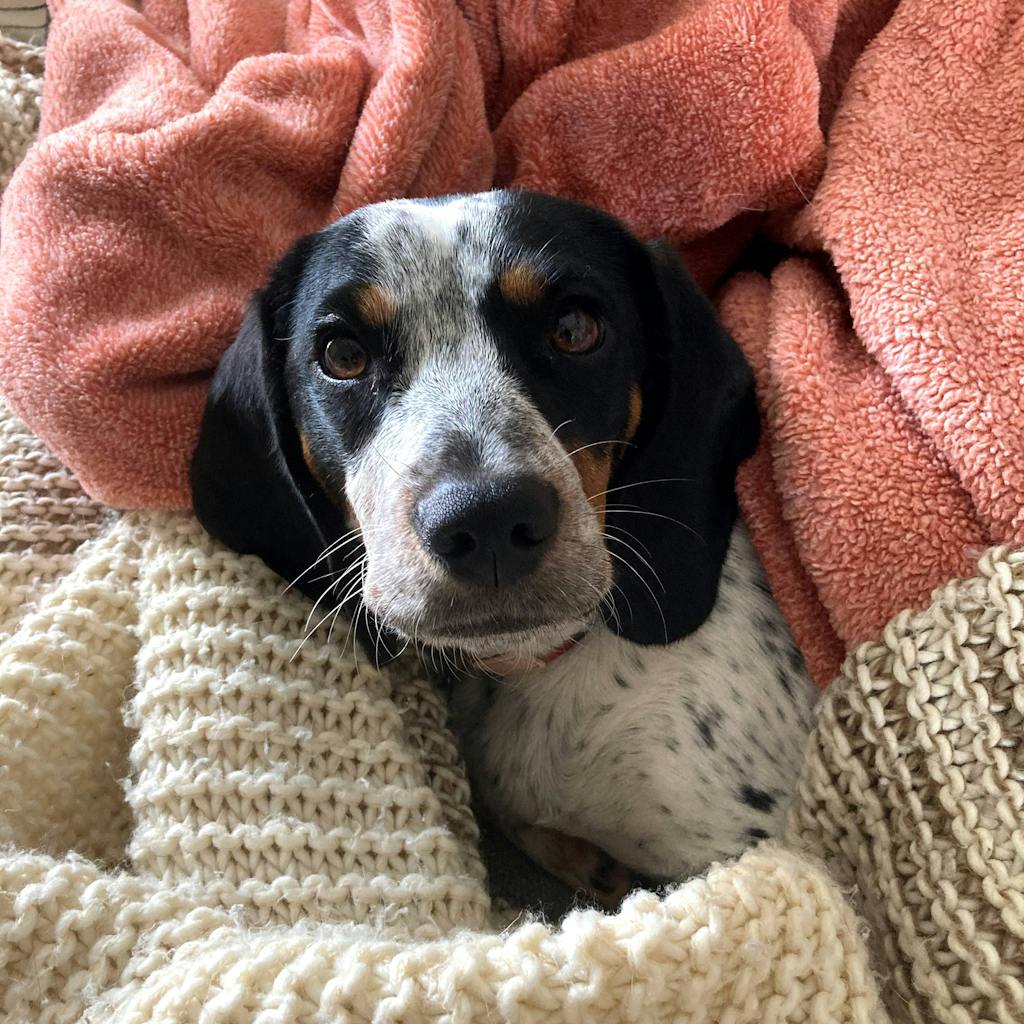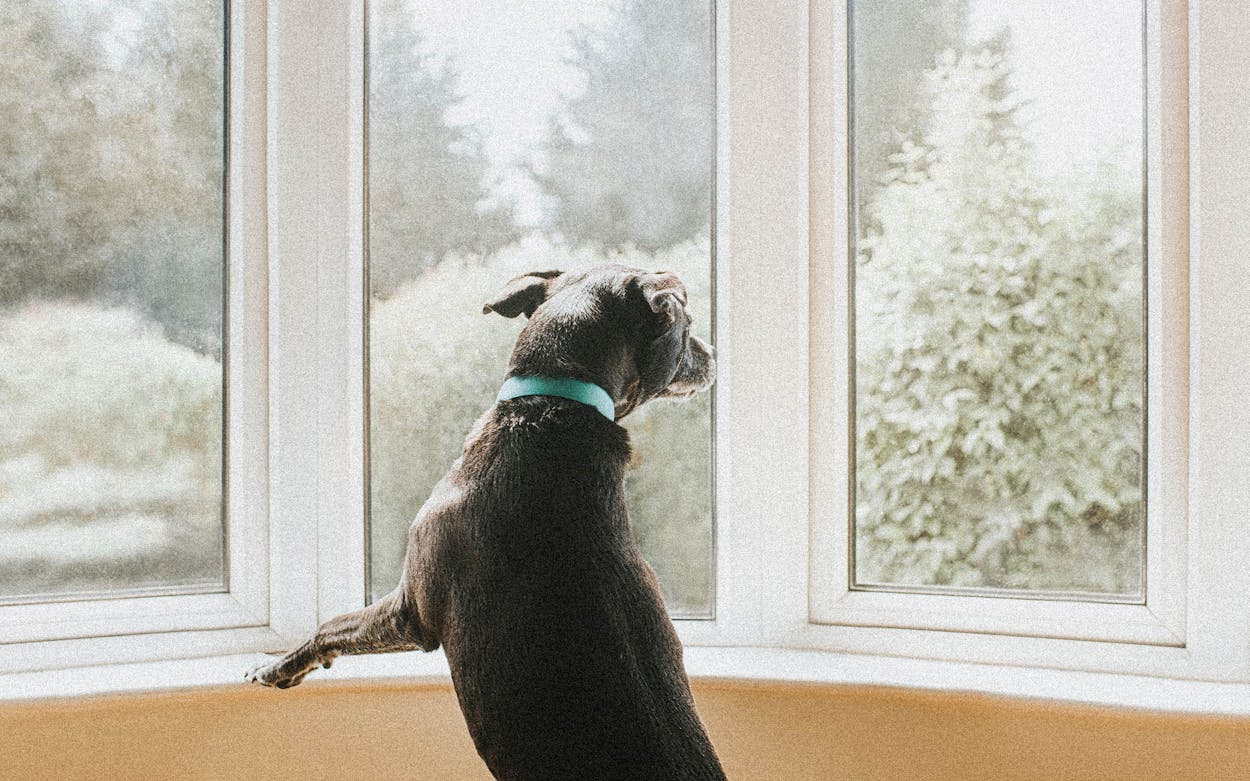Last July, I brought home an eight-week-old beagle not even the size of my foot, and named her Dolly. It was hardly a novel decision: nearly half of Americans adopted a dog during the past year, according to a survey by the pet care company Rover. The pandemic seemed like the ideal time to find a furry friend—when else would I be around full-time to potty train, manage, and enjoy a frolicking, adorable new companion?
Everything was as sweet as a Purina commercial until January, when a move took us away from Dolly’s dog friend, a chill black lab, and made her the only animal in a one-pet household. When I began leaving my new place for errands or outdoor gatherings, I’d return to a whining dog, a tattered carpet, and possessions flung throughout my room. As the world opened up more, Dolly got progressively worse. The pet I’d acquired to stave off some loneliness couldn’t stand to be alone.
As we emerge from the pandemic, humans are languishing—but our dogs are having a hard time too, especially as owners return to in-person work, refill social calendars, and book travel plans. Our pets are learning a new routine, one that doesn’t involve 24/7 couch cuddles. Many of them are experiencing being alone for the first time, and many, like Dolly, are finding it difficult to adjust.
When I now tell people Dolly has separation anxiety, I imagine they picture a neurotic, shaky Chihuahua or a fragile Victorian lady with nerves. Friends are surprised to find she’s calm (for a one-year-old), so long as people are around; it’s only when I leave that she becomes a destructive chaos monster. But separation anxiety in dogs is a real phobia. In mild presentations, a dog might pant, pace, bark, or whine. In more extreme cases, they may defecate, urinate, destroy furniture or door frames, and sometimes even escape. A quick accounting of Dolly’s damage includes pulled-up carpet, murdered plants, tattered blinds, urine stains, and a shattered glass lamp. Plus lots of tears—hers and mine.

While the phobia directly affects pets (cats can suffer too), owners deal with auxiliary anxiety about their animals and their freedom. I feel like I’m stuck in phase two of quarantine, unable to resume “normal” life because of the best friend who helped me through the past year.
“Owners feel like they’re prisoners to their pets” when dealing with this issue, says Amanda Florsheim, a veterinarian and certified behavior consultant with Veterinary Behavior Solutions Dallas. “It makes it hard to say ‘No, I can’t get drinks because I can’t leave my dog alone.’”
Though separation anxiety is usually treatable, the months-long training process can be tedious, expensive, and frustrating. Sadly, that means many dogs are surrendered to shelters because of their anxiety-related behaviors. According to the FDA, three of the ten most common reasons for surrendering are related to separation anxiety.
“There are very few things I can come in and do for people and dogs that will affect their quality of life so radically,” says certified separation anxiety trainer Kim Roche. “Sometimes when I come in, couples are on the verge of breaking up because they’re really stressed out, or the dog is on the verge of losing their home or even being euthanized.”
As the only certified separation anxiety trainer in Austin, Roche sees a lot of canine clients with the phobia. Demand for her services has skyrocketed since the pandemic. Inquiries for separation anxiety cases are up 65 percent since February 2019, Roche says. Florsheim, the Dallas vet, is booked through January, a lead time that isn’t typical for her practice. She says business really picked up as vaccines began rolling out.
“It’s a very chicken-and-the-egg thing,” says Roche. “How many of the dogs I’m seeing are having separation anxiety because they haven’t been left alone for a year, and how many cases were masked because everyone was at home for a year?”
Florsheim is seeing three varieties of sufferers: dogs who previously had the phobia and regressed over the past year; dogs who developed it over the past year of constant companionship; and dogs who were adopted during the pandemic by owners who were unaware of the separation anxiety—until now.
Cases were rising even before the pandemic, though. In part, that’s a result of new technology such as Furbo and Ring cameras, which let owners spy on pets while they’re alone. Milder cases of separation anxiety that might’ve previously gone undetected now seem like cause for concern.
“Now we realize the secret life of dogs is sometimes kind of lonely,” Roche says.
Texas Monthly asked Roche, Florsheim, and Justin Cloud, trainer and founder of Lubbock’s Modern Dog Training Company, for their best advice on how pet owners can combat separation anxiety. May their tips help you and Fido out.
Don’t let them cry it out.
“A lot of the time, when dogs are suffering from separation anxiety, they don’t get better over time, they get worse,” says Roche.
On Facebook, separation anxiety support groups are flush with complaints of well-meaning friends telling owners to “Just leave the dog at home” or “Let them cry it out.” But isolating the dog only exacerbates its fear, and reinforces the idea that alone time is scary. Separation anxiety isn’t something a dog can get over or grow out of without help. Being comfortably alone is a skill the dog must learn over time.
Beware of Google.
When I first discovered my dog’s separation anxiety, I turned to the internet, forgetting that Google is also a master salesman. Over several months, on the advice of blogs that my searches turned up, I bought pheromone diffusers, puzzle toys, CBD supplements, and a scat mat to keep her from ruining the carpet. I very nearly bought this insane-looking $200 device in the hope that I might one day be able to grocery shop again. And I could have gone further with pet psychics, ThunderShirts, indestructible crates, or DogTV.
Generally, such tools will work only for dogs with mild anxiety. Roche compares it to a fear of flying: magazines, movies, and snacks might distract someone with a mild discomfort on planes. But more serious cases will probably require medication or therapy. It’s tempting to fork over money for the silver bullet, but there is no silver bullet when it comes to separation anxiety.
Start by leaving your pup for only a short time.
The one tried-and-true method of treating separation anxiety is consistent counterconditioning. Some people call this method “graduated departures” or “subthreshold training.” Essentially, the idea is to leave your dog for ever-increasing periods of time, never going over their threshold of anxiety, so that they gradually become comfortable with alone time. The process takes several months depending on the dog, and can be done with a trainer, typically virtually, or on your own.
If you do go the professional route, seek out a trainer who specializes in separation anxiety, or a veterinary behaviorist, a vet who has completed four extra years of school and can prescribe medication.
Tire your pup out before you leave (and leave nonchalantly).
Fulfilling a dog’s basic mental and physical needs before leaving home is key, says Justin Cloud, the Lubbock trainer. Take your pup for a long walk or play an interactive game before beginning the departure training described below.
Cloud also suggests making departures no big deal. Leave the house without a big fuss that might heighten your dog’s alertness. “[Try] to make sure, when you do separate, to not add a lot of anxiety yourself,” he says.
Be consistent.
One of the first tenets of separation anxiety is “Thou shall not leave thy dog alone” for longer than he can handle. To ensure that the dog never experiences full-blown panic, reinforcing its fear of isolation, owners need to commit to managing absences while training. As Kim clarifies, “That doesn’t mean you can’t leave them, that just means you can’t leave them alone.”
Options for managed absences include doggy day care, dog walkers, and house sitters. If appropriate, you can also take your dog with you when you go out. No one is more intimate with an establishment’s pet policy than a separation anxiety dog owner.
For persistent cases, consider medication.
Anti-anxiety meds aren’t a cure-all, but if behavioral training alone isn’t cutting it, pills can be a helpful and temporary measure. “It can get them to a point where they’re thinking and learning instead of panicking,” says Roche.
It was harder to wrest a Trazodone prescription from my vet than it was to get a Prozac script from the family doctor. Roche says she’s seen that changing in the past ten years, as more vets come to consider behavior part of a dog’s overall well-being. She says dog owners are sometimes worried that a script will change their pet’s personality, but at the correct dosage, it shouldn’t. Plus, dogs can be weaned off of medication once they’ve successfully learned to be alone.
When Dolly and I first started training in April, she could manage about thirty calm seconds before the panic set in. She can now remain alone—typically napping on the couch—for one hour and twenty minutes, just enough time for a trip to H-E-B. I can taste freedom.








